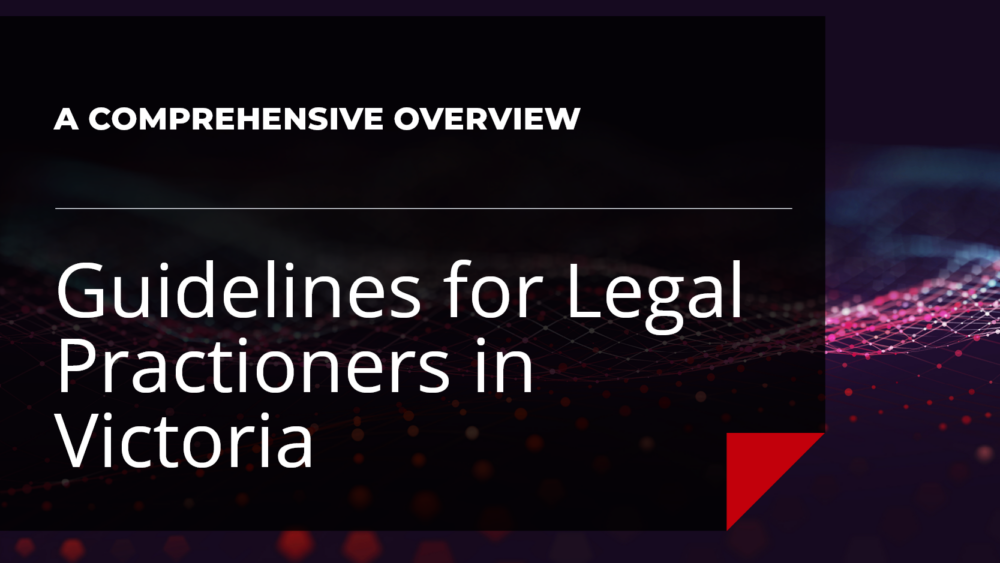The Victorian Supreme Court has set a pioneering benchmark by releasing guidelines for the responsible use of AI in litigation, marking the first time an Australian court has specifically addressed the role of AI for legal practitioners. These guidelines are expected to shape future standards and potentially influence other courts nationwide.
The landscape of the legal industry is rapidly transforming with the integration of artificial intelligence (AI) tools. Recognising this evolution, the Victorian Supreme Court has set a pioneering benchmark with the release of guidelines for the responsible use of AI in litigation. This initiative marks a significant milestone, as it is the first time an Australian court has specifically addressed the role of AI for legal practitioners, moving beyond the Guidance for AI use by non-lawyer litigants published by the Queensland Courts.
While Australia has yet to implement uniform laws or practice notes regarding AI use in court proceedings, these guidelines from the Victorian Supreme Court are anticipated to shape future standards, potentially influencing other courts nationwide.
Guidelines for AI Use in Litigation
The guidelines are designed to assist both legal practitioners and self-represented litigants in navigating the complexities of AI in legal settings. Here’s a closer look at the key principles outlined:
1. Understanding AI Tools
Legal practitioners and litigants must comprehend how AI tools function and their limitations. This knowledge is crucial for effective and ethical application in legal tasks.
2. Privacy and Confidentiality:
Users must be aware that data provided to AI programs may not be secure, and confidentiality cannot be guaranteed.
3. Transparency and Disclosure:
The use of AI in legal processes should not mislead other participants, including the court. Parties are encouraged to disclose AI assistance in their legal tasks to ensure transparency.
4. Adherence to Legal Obligations:
The use of AI must align with legal practitioners’ obligations, including the duty of candour to the court and compliance with the Civil Procedure Act 2010.
5. Identification by Self-Represented Litigants:
Self-represented litigants using AI to prepare documents should identify the AI tool used. This helps provide context for judicial officers to assess the litigant’s legal knowledge and experience accurately..
6. Leveraging AI for Efficiency:
AI, especially specialised legal AI tools, can significantly enhance productivity and efficiency in litigation. The use of such technology, including Technology Assisted Review (TAR) for large-scale document review, is encouraged.
7. Critical Evaluation of AI Outputs:
AI-generated text should be thoroughly checked for accuracy, completeness, and relevance to the jurisdiction. Legal practitioners remain responsible for the content they sign or certify.
8. Caution with Affidavit and Witness Materials:
Particular care is needed when AI tools assist in preparing affidavits, witness statements, or expert reports to ensure the content accurately reflects the witness’s knowledge and words.
9. Judicial Use of AI:
While AI tools can offer various benefits, they are not used for decision-making or preparing reasons for decisions, as they lack the capacity for specific reasoning required in judicial processes.
Key Takeaways for Legal Practitioners
For legal practitioners, the Victorian Supreme Court’s guidelines on AI use in litigation provide crucial insights and responsibilities. Firstly, understanding the functionality and limitations of AI tools is essential to effectively incorporate them into legal tasks. Ensuring data privacy and maintaining confidentiality are paramount, as AI programs may pose security risks. Transparency is critical; practitioners should disclose AI assistance in their legal processes to avoid misleading the court and other participants. Adhering to legal obligations, including the duty of candour and compliance with the Civil Procedure Act 2010, remains a cornerstone of ethical practice. Lastly, practitioners must critically evaluate AI-generated content for accuracy, relevance, and completeness, particularly when preparing affidavits, witness statements, and expert reports. By following these guidelines, legal practitioners can leverage AI’s benefits while upholding the profession’s integrity and ethical standards.
Setting the Standard for the Future
The Victorian Supreme Court’s guidelines represent a proactive step toward integrating AI in legal practices responsibly. As the capabilities of AI continue to grow, these guidelines will likely serve as a foundational reference for other courts, fostering a uniform approach to AI use across Australia’s legal landscape.
By embracing these guidelines, legal practitioners and litigants can harness the power of AI to enhance efficiency and accuracy in their work, while upholding the integrity and ethical standards of the legal profession. The future of AI in litigation is promising, and these guidelines ensure that its integration is both innovative and responsible.
Read more: https://www.supremecourt.vic.gov.au/sites/default/files/2024-05/AI%20Guidelines%20SCV.pdf

Need help with legal technology project? Discuss your requirement directly with our expert team for personalised guidance and tailored solutions.
About Law Image: Law Image is a leading information management company. Headquartered in Melbourne, we have offices in Sydney, Brisbane, and Perth. Law Image support law firms, government departments, and other industries across Australia with end-to-end document management and legal technology solutions.
For Marketing & Branding enquiries, contact:
Siddhi Chavan (communications@lawimage.com)
Marketing Specialist




Comments are closed.